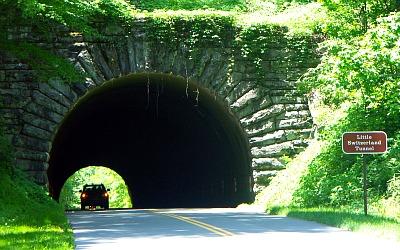This nearly 500-mile meander has it's own set of rules and challenges. From speed limits to weather, tunnels to tight turns, it's best to be prepared for the Blue Ridge Parkway.
A Parkway Motoring Primer
Speed
The Parkway speed limit is 45, with occasional areas of 35 mph, and limits of 25 mph in some congested pedestrian areas.
Motoring Challenges

The Parkway's many tunnels are a great part of the Parkway experience. Photo by Randy Johnson.
Not everyone feels confident when driving curvy mountain roads'and the Parkway is one of the curviest! The Parkway is a relatively narrow road with abrupt and at times grassy shoulders, steep grades, sharp turns, and the sudden appearance of new traffic challenges around each bend. Keep your eyes on the road'and pull into one of the hundreds of overlooks when you want to really gaze at the world below.
Courtesy
Relax and enjoy the view'¦but. There are few passing zones on the Parkway, and many locals use the road as their best route between home and work. At times, even dawdling Parkway motorists realize they have a distant hotel reservation and need to drive the legal limit. Bottom line: Frequent overlooks make it easy to just pull over and let everyone get by. Please do not let traffic gather behind you.
Wildlife
The Parkway slices through large tracts of national forest and animals frequently cross the road. Be extremely cautious near dawn and dusk as wildlife of all kinds, including deer, is active. Plan ahead so you're not 'making up time' early or late in the day. You're the visitor: please be cautious.
Road Closures
Severe weather and rockslides may close portions of the Parkway without warning. Repairs and ongoing maintenance may also close sections of the road. To plan ahead, visit the park's web site, and click 'Closures' under Quicklinks on the homepage (or call 828-298-0398).
Tunnels
Turn on headlights in Parkway tunnels and be on the lookout for bicycles. If you're driving an RV, consult the minimum height chart on the Parkway's tunnel page to be sure your vehicle has sufficient clearance.
Cell Phones
If you want to use your cell phone, do so in bigger towns or be on the lookout for whenever those bars appear! Many parts of the Parkway are absolutely devoid of cell service.
Parking
Parking is available at trailheads and many overlooks. It is also permitted to simply pull off the Parkway and picnic by your car on the grassy shoulder of the road. If you do use the roadside, make sure the car is well off the road and don't park on soft ground that might be damaged by your vehicle. Lock valuables in your car where they can't be seen from outside, or take them with you.
Weather
Expect cool temperatures any time of year. Even at the peak of summer, mountaintop temperatures are often 10 or more degrees cooler than surrounding valleys. Hot days are rare on the Parkway's higher elevations (upper 70s is usually the max), but it can be warm at the lowest spots (near 90), especially near Roanoke and the James River in Virginia. Many summer days bring cooling thunderstorms, so a rain jacket and added layers of clothing should always be in a hiker's pack. Night-time lows in summer are usually in the 50s and 60s. Spring and fall can turn cold with little warning. Snow has fallen on the Parkway in September and May, but October and April are more likely to see the first or last flakes. Winter snows can be deep and snowy weather can last for weeks. Parkway signs admonish motorists to 'Avoid the Parkway in Fog, Snow, and Ice.'
You'll never see fog denser than on the Parkway. At the park's high elevations, you can find yourself driving in a cloud. Best advice is to slow down or call it a day.
The Parkway often closes gates to restrict traffic when snow and ice warrant. If sudden snow or icing occurs, expeditiously exit the Parkway to more regularly plowed public highways.
Even when the road is open, use caution during cold weather. Sheltered and exposed parts of the Parkway pose unique hazards, as evidenced by 'Beware of Sudden Icing' signs. Dry pavement can suddenly become wet in a shady curve'and that can mean a sudden change to glare ice in colder months.
In warm weather, a wet, shady turn can also be slick. And rain can make the Parkway's steep grades and sharp turns particularly tricky.


